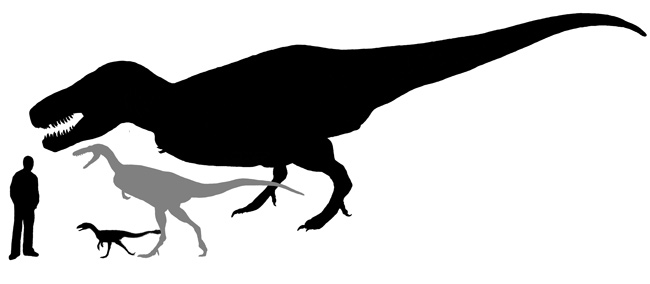When T. Rex Became Tyrannical

This isn't your daddy's Tyrannosaurus Rex. The king of the dinosaurs evolved from ancestors that spent most of their evolutionary history skulking in the shadows of other giant predators, and may have even sported hair-like feathers.
T. rex made a late evolutionary arrival on the dinosaur scene, according to the latest paleontological evidence. Earlier tyrannosaurs remained the size of humans until about 80 million years ago, said Stephen Brusatte, a vertebrate paleontologist and evolutionary biologist at the American Museum of Natural History in New York City.
"Up until about ten years ago we only knew about T. rex and a handful of its closest relatives – all colossal, apex predators from the end Cretaceous in North America," Brusatte explained. "Now we know of about 20 tyrannosaur species that span a time period of 100 million years, most of which are very small."
Multi-ton late-Cretaceous specimens had defined scientific understanding of the tyrannosaurs since the first discovery 105 years ago. But the last decade saw an explosion of tyrannosaur discoveries that doubled the family's diversity, including six new species in the last year alone.
Now Brusatte and colleagues have created the first comprehensive family tree for tyrannosaur cousins large and small, as detailed in the Sept. 17 issue of the journal Science.
Supersize me
The family tree shows how tyrannosaurs first originated about 165 million years ago during the Middle Jurassic. They remained mostly small, fast-footed dinosaurs just one hundredth the size of T. rex.
Get the world’s most fascinating discoveries delivered straight to your inbox.
In fact the late-Cretaceous tyrannosaur giants looked more like their nimbler ancestors as young dinosaurs, capable of more active hunting. But then they grew rapidly to reach full maturity at the age of 20, putting on more than 4 pounds (2 kg) per day, and losing much of their fancy footwork.
Such growth spurts allowed the late tyrannosaur adults to weigh in at 11,000 to 17,600 pounds (5 to 8 metric tons), but also limited their running speeds to between 16 and 36 feet per second (5 and 11 meters per second). By comparison, a racehorse running full-tilt can hit speeds of almost 66 feet per second (20 mps).
Hungry, hungry dino
T. rex made up for its slow movement with keen hearing and smell, as well as a bone-crushing bite that might have topped 3,000 pounds of force (13,400 newtons). Bite marks on a wide variety of dinosaur fossils reveal that it was no picky eater, and probably represented both a hunter and scavenger.
Researchers still don't know why tyrannosaurs got a shot at quickly becoming top predators during the twilight years of the dinosaurs. But the fossil record shows that many other giant predators had gone extinct by about 80 million years ago, and tyrannosaur body size exploded soon after.
"We hypothesize that the giant size of tyrannosaurs was only possible once other large predators went extinct, giving tyrannosaurs the space and freedom to flower and become apex predators," Brusatte told LiveScience in an e-mail.
Many other questions about tyrannosaurs also remain, despite the fact that the group represents perhaps the best-studied among the dinosaurs.
Riddles upon riddles
For instance, speculation about T. rex having hair-like feathers comes from knowledge that one species of tyrannosaur, Dilong paradoxus from the Early Cretaceous period of China, had such features. Earlier ancestors also carried the feathery plumage.
"Because tyrannosaurs clearly weren't flying, it is likely that their feathers were used for display or insulation," Brusatte said.
Figuring out the sex of each tyrannosaur from a specimen has also proved baffling. Researchers have recently hit upon a "100-percent foolproof" method of looking for medullary bone tissue – a calcium phosphate used in creating eggshells within female dinosaurs. But that relies upon finding a fossilized female that had been ovulating.
One of the most exciting areas of research involves the possible discovery of soft tissues, such as cells, blood vessels and collagen, in one tyrannosaur specimen. Although controversial, the findings could overturn ideas about what body parts can survive fossilization. They might even lead to the possibility of preserved dinosaur DNA.
"We have come a long way in our understanding of dinosaur biology, and of dinosaur genealogy,” Brusatte said, “ but one of the joys of paleontology is that each new fossil has the potential to tell us something new, and even to overturn ideas we once thought were bulletproof."
 Live Science Plus
Live Science Plus






